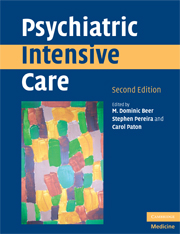Book contents
- Frontmatter
- Contents
- List of contributors
- Preface to second edition
- Preface to first edition
- Foreword
- Part I Therapeutic interventions
- 1 Psychiatric intensive care – development and definition
- 2 Management of acutely disturbed behaviour
- 3 De-escalation
- 4 Rapid tranquillisation
- 5 Pharmacological therapy
- 6 Psychological approaches to the acute patient
- 7 Psychological approaches to longer-term patients presenting with challenging behaviours
- 8 Seclusion – past, present and future
- 9 Restraint and physical intervention
- 10 The complex needs patient
- 11 Therapeutic activities within Psychiatric Intensive Care and Low Secure Units
- 12 Risk assessment and management
- Part II Interface issues
- Part III Management of the Psychiatric Intensive Care Unit/Low Secure Unit
- Index
- References
8 - Seclusion – past, present and future
from Part I - Therapeutic interventions
Published online by Cambridge University Press: 22 August 2009
- Frontmatter
- Contents
- List of contributors
- Preface to second edition
- Preface to first edition
- Foreword
- Part I Therapeutic interventions
- 1 Psychiatric intensive care – development and definition
- 2 Management of acutely disturbed behaviour
- 3 De-escalation
- 4 Rapid tranquillisation
- 5 Pharmacological therapy
- 6 Psychological approaches to the acute patient
- 7 Psychological approaches to longer-term patients presenting with challenging behaviours
- 8 Seclusion – past, present and future
- 9 Restraint and physical intervention
- 10 The complex needs patient
- 11 Therapeutic activities within Psychiatric Intensive Care and Low Secure Units
- 12 Risk assessment and management
- Part II Interface issues
- Part III Management of the Psychiatric Intensive Care Unit/Low Secure Unit
- Index
- References
Summary
Introduction
Whether seclusion has a place within the treatment of the mentally disordered is one of the longest running debates in the history of mental health care and it is likely to continue. Controversial deaths in mental health facilities and their subsequent inquiries will further fuel speculation as how best to manage challenging behaviour. The Independent Inquiry into the Death of David Bennett (Norfolk, Suffolk and Cambridgeshire Strategic Health Authority 2003) questioned whether the use of seclusion may have been preferable to prolonged restraint.
The use of seclusion is at least 2000 years old and many of the related questions have remained consistent, surviving to the modern day. It is not the intention of this chapter to re-describe the moral, ethical and legal paradigms that have punctuated much of seclusion's history. The focus here will be to provide an overview of the history of seclusion, its value or otherwise, its alternatives and the necessary supporting policies for its use. Finally, we will offer a practical framework within which seclusion may be considered in the context of Psychiatric Intensive Care Units (PICUs) and Low Secure Units (LSUs).
For the purpose of this chapter seclusion is defined as ‘the forcible confinement of a patient alone in a room for the protection of others from serious harm’ (Mental Health Act 1983: Code of Practice; Department of Health 1999).
Seclusion is widely used throughout the world (Mason 1994).
- Type
- Chapter
- Information
- Psychiatric Intensive Care , pp. 106 - 122Publisher: Cambridge University PressPrint publication year: 2008
References
- 2
- Cited by

